The Cornell Lab Bird Academy › Discussion Groups › Nature Journaling and Field Sketching › The Power of Reflection
-
John Muir and John Burroughs come to mind for me when I think of naturalists. I have enjoyed reading materials from both. I also visited the sparse cabin of the American naturalist John Burroughs in Roxbury, NY. It has fantastic views of the beautiful Catskills Mts. You can see the huge rock in a field that Burroughs would often sit on where contemplated nature. I usually wake up early. Most of the time it is just before dawn when the sky is a l pale blue-white but brightening. Sometimes It may be cloudy too but interesting enough I found out that if you have patients you may suddenly see clouds move away and slight hints of pink appear, and if you stay with it you may see rays of color suddenly dash across the sky like a pale watercolor wash. But if you can keep watching you may see transformations that will “amaze”you. I found out that I had some beautiful sunrises that looked like pictures I had taken on vacation but to my surprise this was in my own backyard while I was sleeping . I have developed an interest in watching as many sunrises as I can. I love seeing the first rays of sun creep along the horizon with very dramatic effects at times. This all happens just as the sun is coming up and it’s a magical time. It won’t last too long, and every sunrise is different. That’s nature. Prepare to be “amazed” !


-
April 11,2021 whether near a stream or in the woods on a trail or off the beaten path I sometimes find myself in a daze after a busy intent day at work., its a way to find peace. I can unwind in nature either nature journaling , bird watching or trying to find the perfect photography setting of a bird that can stay still. what is important is being still and patient, staying still taking in your surroundings to notice things and alerting your senses. This past week I was walking around a lake photographing any waterfowl that may be around and that I heard that have been spotted by other birders. I decided to take a side route, trail that was quieter than the trail I was on. walking around a bend I noticed a male goose standing on a ledge which told me not to disturb him so I walked far around him not to disturb him. where was it's mate? well on the far side of the gorge there she was walking around a patch of circular white patches, stunning!!! clutch of eggs were laid on a cliff of a gorge. I was very far from disturbing a the geese and snapped a photo of the mother goose and it's eggs; I walked away without disturbing their peace.


-
John Muir. Wisdom for the ages. My favorite writer. He sometimes wrote with a near aching poignancy about the simpler things in nature.Claire Walker Leslie for nature journaling.
-
As a child, I spent summers in the country near Lake Michigan. I developed a real love of Nature and read a lot of Haiku. As a young adult, I enjoyed reading Thoreau and Emerson. When I retired, I started gardening for wildlife and reading about spiritual ecology. One of my favorite books is "Spiritual Ecology: The Cry of the Earth" by L. Vaughan Lee. Some of the books I've learned the most from are "Half-Earth: Our Planet's Fight for Life" by Edward O. Wilson, "Gaia's Garden" by Hemenway, and "Inheritors of the Earth" by C. Thomas. Some books about birds that I enjoyed the most are "Why Birds Sing" by Rothenberg, "The Gift of Birds" ed. Habegger, and "Gods of the Morning" by Lister Kaye.
-
I really don’t have any particular nature writers. Audubon of course as we have many bird books. The only thing I could think of was a beautiful rose that bloomed through the recent....last week... we had a severe Ice Storm. Trees down, electricity out for days, freezing cold, wires down. But Joseph’s coat rose bloomed as if nothing happened. I hope you enjoy te photo...

-
Everything about Rachel Carson’s life and writings have inspired me, from my early years as a teen in the 1970’s to the present. There is still so much to learn from her. John James Audobon’s Birds of North America will forever be my favorite illustrated guide to birds. I love the exquisite details in his illustrations. I also have a collection of Clare Walker Leslie’s guides for journaling and sketching, and most recently Jean Mackay’s The Nature Explorer’s Sketchbook , For the Art of Your Discoveries. I’m inspired by their encouraging presentations of techniques for beginners like me. I haven’t begun writing reflections very much yet in my journaling, but this course has opened that window for me to explore. This course has given me so much to go forward with, to better appreciate the amazing natural world all around us, in every corner of the world. I’m having so much fun now, experimenting with sketching birds and creatures outside my window and on local hikes during this winter of pandemic confinement. Thank you, Liz, and Cornell for bringing this course into my home.

-


-
Thanks for sharing.
-
-
John Muir is my favorite because of my Biology and Environmental Science classes but the best poem (my dad taught me this poem when I was little) has been TREES by Joyce Kilmer I think that I shall never see A poem as lovely as a tree. A tree whose hungry mouth is prest Against the earth’s sweet flowing breast; A tree that looks at God all day, And lifts her leafy arms to pray; A tree that may in summer wear A nest of robins in her hair; Upon whose bosom snow has lain; Who intimately lives with rain. Poems are made by fools like me, But only God can make a tree. Now, I am working on my poem...
-
Lovely. Thanks for sharing.
-
Thank you for reminding me of this beautiful poem. My mother recited it as a child and then to me in later years.
-
-
A background in nutrition led me to Wendell Barry's writing that I like a lot. I look forward to someday having/taking time to read Vita Sackville West writings about gardening. Thanks for the good examples of writings on nature. I have made additions to my book list. My rather unpoetic reflections about observations, or lack of them, follows. Upon starting nature journaling and observing the specifics of my surroundings more closely, I realized that I was missing opportunities. Prioritizing 'responsibilities' causes me to fast-pace by ongoing processes in nature that occur right under my nose. A new mahonia, thankfully thriving and happy in its' soil, pot and location in our back yard, threw out brilliant cadmium yellow blooms that were designed to turn the most preoccupied heads. The more subtle but no less beautiful berries that the blooms yielded, made me realize that nature offers gifts every minute of every day and that sometimes the necessary 'slow down' for a closer look can be richly rewarding!
-
I enjoyed Rachel Carson's piece, I could hear the chorus of birds through her writing. I also enjoyed the piece about strawberries - feeling the sun's warmth, the smells, and seeing the actual strawberries in my mind. Here's my journal from Nov. 4 2020; I spotted one of three Heron's that frequent the ponds near me in Ottawa. I wrote today adding to it, from the Heron's perspective: "Oh lady, won't you ever leave me be? I see you approach, quiet, respectful, but I see you there. With your tools and curious eyes. I don't want to be seen yet here you are. Our eyes meet and nervous, you make me! On edge, I wade. On edge, I wait. Until it becomes unbearable for me to sit in peace. I fly away to another corner far away from you. "

-
 11/26/2020 Outside my Window.
What a delight, on Thanksgiving morning, to see a buck outside my dining room window just staring at me. He out-stared me, for what seemed a long time, and I finally backed away so as not to frighten him. With his measure of safety he proceeded to the backyard, piled high with fallen leaves, and first enjoyed a tasty laurel then a number of succulent bushes here and there. To my surprise, the main dish was then in the fallen leaves. He sorted through them, so it wasn’t just any leaf, but special ones. I’m not entirely sure, but it looked like it was the older leaves, wet and closer to the ground, he was after. He traveled back again to the side of the house; delicately picking just the right fallen leaves. For these magical moments, I am grateful.
What a delight, on Thanksgiving morning, to see a buck outside my dining room window just staring at me. He out-stared me, for what seemed a long time, and I finally backed away so as not to frighten him. With his measure of safety he proceeded to the backyard, piled high with fallen leaves, and first enjoyed a tasty laurel then a number of succulent bushes here and there. To my surprise, the main dish was then in the fallen leaves. He sorted through them, so it wasn’t just any leaf, but special ones. I’m not entirely sure, but it looked like it was the older leaves, wet and closer to the ground, he was after. He traveled back again to the side of the house; delicately picking just the
right fallen leaves. For these magical moments, I am grateful.
11/26/2020 Outside my Window.
What a delight, on Thanksgiving morning, to see a buck outside my dining room window just staring at me. He out-stared me, for what seemed a long time, and I finally backed away so as not to frighten him. With his measure of safety he proceeded to the backyard, piled high with fallen leaves, and first enjoyed a tasty laurel then a number of succulent bushes here and there. To my surprise, the main dish was then in the fallen leaves. He sorted through them, so it wasn’t just any leaf, but special ones. I’m not entirely sure, but it looked like it was the older leaves, wet and closer to the ground, he was after. He traveled back again to the side of the house; delicately picking just the right fallen leaves. For these magical moments, I am grateful.
What a delight, on Thanksgiving morning, to see a buck outside my dining room window just staring at me. He out-stared me, for what seemed a long time, and I finally backed away so as not to frighten him. With his measure of safety he proceeded to the backyard, piled high with fallen leaves, and first enjoyed a tasty laurel then a number of succulent bushes here and there. To my surprise, the main dish was then in the fallen leaves. He sorted through them, so it wasn’t just any leaf, but special ones. I’m not entirely sure, but it looked like it was the older leaves, wet and closer to the ground, he was after. He traveled back again to the side of the house; delicately picking just the
right fallen leaves. For these magical moments, I am grateful.
-
I like the economy of words in writing haiku because otherwise I don’t focus as well. I use it often to describe things in nature. Bushtit Haiku: Blow in quick, gone fast Kamikazi moves Lightning strike waves on feeder. Group ESP flash Feasting swarm ALERT! Blizzard of bushtits, poof! Gone!

-
Was really inspired to look at some of the authors mentioned that I had not read before. John Muir, Rachel Carson, Thoreau have always been favorites. I have never been one to wax poetic, but found the reflection exercise interesting. I will try to include more of this in my journal.

-
I enjoyed your watercolor of zinnias and butterflies , Jean. I have had zinnas before but, now I have Turk's cap in my front yard. The Turk's cap are solitary red in color that attract hummingbirds, butterflies, bumblebees and small lizards. I have observed the hummingbirds for the whole month of September and into early October this year and probably soon the hummingbirds will be moving further south. The Turk's Caps will continue to flower until the first frost and will return again in the spring with their magnificent red blossoms. Your watercolor of zinnias
 as has inspired me for something similar but with Turk's Cap instead.
as has inspired me for something similar but with Turk's Cap instead.
-
-
 From The Perspective Of A Mantis Observing Me:
When I walked back home and got to the door of my house, I felt an uncomfortable feeling that someone was watching me. As I opened the door, the feeling became very intense. I looked scared to my right and saw two round eyes. The little mantis analized me for a long time. Sometimes I am the Observer, other times I am observed. I was surprised by the strength of her presence. I wonder what these creatures think of us.
From The Perspective Of A Mantis Observing Me:
When I walked back home and got to the door of my house, I felt an uncomfortable feeling that someone was watching me. As I opened the door, the feeling became very intense. I looked scared to my right and saw two round eyes. The little mantis analized me for a long time. Sometimes I am the Observer, other times I am observed. I was surprised by the strength of her presence. I wonder what these creatures think of us. -
It was wonderful to see we shared so many favorite authors, Mary Oliver, Bernd Heinrich, Terry Tempest Williams, Aldo Leopold to name a few. Thanks to all who mentioned John Muir, I will be revisiting his work. As I spend time in the garden this time of year (October), there is the "should" to clean up and put the garden to bed, both vegetables and native plants. As I get older I find this gets less important, no need to disturb the small ecosystems, most of which I am not even aware of. Better to sit and watch, and maybe draw. Thinking of Mary Oliver's poem "Nothing is too Small to be Wondered About", and while watching life happening on the mountain mint, I saw what looked like tiny flowers moving on the leaves. What an amazing discovery for me. The larvae of the Wavy-lined Emerald Moth, which nibbles off pieces of the flower petals it eats and sticks them on it's back for camouflage and if it moves to a different plant (new color), will change the camouflage to match. Indeed there is nothing too small to be wondered about.

-
 The context for my nature journaling and reflection is set against the backdrop of fire and smoke. I live in Portland, Oregon. We had rented a vacation home in eastern Oregon, months ago. Our plans were to hike and get out into the wilderness of the Cascades. The dangerous levels of smoke in the air that week forced us to stay inside.
After our last dinner, my husband began the preliminary packing of the car for the trip home the next morning. He stuck his head in the door and whispered, “You’ve got to come out here. Be really quiet. There’s a black-tailed deer bedding down, just behind the house.” I quickly grabbed my sketchbook, marveling that I might actually have a nature experience to draw! Quietly I sat down about a dozen feet from the doe. I was amazed that she didn’t flee. Her large ears and eyes stayed focused on me for a bit until she decided I was not a threat.
I have been around deer all my life, but this was the first time that I had the opportunity to observe one so closely for such an extended period of time. As I drew I appreciated the dimensions of her body, the colors and textures of her coat, the unique markings on her face and how those amazingly large ears swiveled to track the sounds around her, searching for danger.
All of the sudden behind me I heard a sound, an animal sound I’d never heard before. The sound indicated a fairly large animal. It was sort of like a “m” sound, a hum. I froze, looking out of the corner of my eye to see if I was in any danger. However, when I glanced back at the doe, her ears were still. She sat placidly chewing her cud. She sensed no danger so I relaxed. Then, a surprise burst into a view. An independent fawn, still with black spots, bounded around the corner as if to say, “Hey Mom! I’m home!” It was the fawn making that noise! I didn’t know that deer made noises. I watched them, sketching them until dusk made them disappear in perfect camouflage for the night.
My “failed” vacation ended up being one of my favorites. I learned many lessons about being still. The lesson I hold most closely came from those two deer. Even amidst the worst of times, there is beauty and wonder if you keep your eyes open and embrace opportunity.
The context for my nature journaling and reflection is set against the backdrop of fire and smoke. I live in Portland, Oregon. We had rented a vacation home in eastern Oregon, months ago. Our plans were to hike and get out into the wilderness of the Cascades. The dangerous levels of smoke in the air that week forced us to stay inside.
After our last dinner, my husband began the preliminary packing of the car for the trip home the next morning. He stuck his head in the door and whispered, “You’ve got to come out here. Be really quiet. There’s a black-tailed deer bedding down, just behind the house.” I quickly grabbed my sketchbook, marveling that I might actually have a nature experience to draw! Quietly I sat down about a dozen feet from the doe. I was amazed that she didn’t flee. Her large ears and eyes stayed focused on me for a bit until she decided I was not a threat.
I have been around deer all my life, but this was the first time that I had the opportunity to observe one so closely for such an extended period of time. As I drew I appreciated the dimensions of her body, the colors and textures of her coat, the unique markings on her face and how those amazingly large ears swiveled to track the sounds around her, searching for danger.
All of the sudden behind me I heard a sound, an animal sound I’d never heard before. The sound indicated a fairly large animal. It was sort of like a “m” sound, a hum. I froze, looking out of the corner of my eye to see if I was in any danger. However, when I glanced back at the doe, her ears were still. She sat placidly chewing her cud. She sensed no danger so I relaxed. Then, a surprise burst into a view. An independent fawn, still with black spots, bounded around the corner as if to say, “Hey Mom! I’m home!” It was the fawn making that noise! I didn’t know that deer made noises. I watched them, sketching them until dusk made them disappear in perfect camouflage for the night.
My “failed” vacation ended up being one of my favorites. I learned many lessons about being still. The lesson I hold most closely came from those two deer. Even amidst the worst of times, there is beauty and wonder if you keep your eyes open and embrace opportunity. -
I was able to sit for 30 minutes or so with a snow bunting today. Then I used the prompt to write this. "Conversing with a Snow Bunting" Snow bunting, here we meet on the dock. Human, here we meet on the dock. Bunting, where did you spend your summer, on what faraway tundra? What is tundra like? I don't know. Human, where did you spend your summer, in what city? What is a city like? I don't know. Bunting, will you winter here or migrate further south? Human, will you winter here or migrate farther south? Bunting, what's that you're finding in the gravel and the grass? Human, what's that you're finding in that flat thing that flaps in the wind? What are you doing with that stick? Bunting, when did your feathers change to wintertime white, caramel, and black? Human, where are your feathers? Bunting, I wish I could talk to you. I'm sorry that I don't speak 'sparrow.' Human, I wish I could talk to you. Sorry, I don't speak human.
-
What a course we need more of them

-
 I enjoy Ralph Waldo Emerson and Henry David Thoreau two famous Transcendentalists. I love to sit in nature soak in the sun, sound of the ocean and a forest bath and just become content in just being.
I enjoy Ralph Waldo Emerson and Henry David Thoreau two famous Transcendentalists. I love to sit in nature soak in the sun, sound of the ocean and a forest bath and just become content in just being. -
Love this one; caught my eye.
-
-
(In response to covid-19 I was looking for quiet road where I could jog and my dog could be unleashed. I found a spot and have returned to it 4 days a week since early April. Much of my drawing has been inspired by what I saw there and now I share part of it with you.) Island and I Early April Island: The ducks are back again, drifting beside me, she in brown, he with his dark head and glowing white eye patch, diving for food then, resurfacing and drifting again. Me: I park opposite this small island in the middle of the Madawaska River, off the gravel road, ready to run with Molly. My eyes are drawn to the river and what looks like chunks of snow floating on it. Eventually I realize that it is ducks but as I draw closer they lift and with a whistling sound quickly disappear. Island: Over the next few days more Goldeneye arrive and some mallard pairs, feeding and seeking places to raise their young. The woman has appeared often, parking her little green car, appearing now and again long the road, stepping out in a small clearing below me with her dog, then disappearing again. Me: I arrive quietly and slip out of the car, binoculars and bird book in hand trying for a clearer view so I can identify these ducks. Finally I decide they are Common Goldeneye. While I observe them for several weeks I never see their nests in hollow trees on the far side of the island nor their young, before they are gone. Early May Island: The Canada geese have arrived. Just a pair make their nest at the tip of me. The nest is away from the road so She will not see it. I wonder when the other pair will arrive. Me: I see a pair of Canada geese floating in a quiet spot at the end of the island. I will have to check it again and see when the young have hatched. When I go down the bank to a sandy stretch I am surprised to see so much black mixed with the pale sand. Looking closer I realize that it is hundreds of emerging black flies. Climbing the bank I lean against a cedar to stretch then see all the small black flies lining it as high as I can see. Hemlocks, maple and poplar are similarly covered. While I may not enjoy my run here next time, the birds should be happy. Early June: Island: I do enjoy the song of returning birds and seeing them flit among the bushes. Jays, kingfishers and sparrows, even wrens fly back and forth. Heron fly down the river and the occasional bald eagle sits atop my tall pines. I wonder if she sees them. Me: There is so much to see along the road. Just the flowers: rosa rugosa, starflowers thimbleweed and cardinal flowers. Some I know but others I have to look up in my wildflower book. Then there was the doe I was watching, lying in the shade on the road when another doe came up from the river right beside me! Both took off while I searched for young. Where are the young? Were these two escaping the deer flies? Another day as I was ending my run, a flutter of swallowtails rose up around me. What joy! They settled on a damp area on the road and could be found there for a couple of weeks. What drew them to that spot? It was no longer a puddle and did not seem to be a source of food? June 18 Island: She has sat there for a long time, looking at me and drawing. Will she capture the rapids and quiet areas which keep the fish and birds returning here? Will see notice my magnificent white pines? Me: It is hard to capture the variety of plants on the island; grasses, bushes, maple or oak and of course the tall white pines. The campers must love lying beneath them. I only wish I could see the other side where the Goldeneyes hid. The colour of the water and the rapids are particularly hard to capture. Three ducks flew up the rapids too quickly to identify. A white-crowned sparrow flits among the bushes beside me, while blue damsel flies dart from water to grass and a red squirrel chatters above me. Molly and I will return because I look forward to seeing more flowers emerge, birds flock up and trees change to their brilliant fall colours. But for today I say good-bye to the Island.
-
Hi Tanis: What a lovely and creative piece of writing. You really spent some time and gave it so much thought. Your family will cherish this. I sincerely enjoyed it and feel I know your running spot a little. Michele
-
-
 This is the most recent entry from my journal. I have watched this Japanese maple for years, sometimes from the chairs I tried to include in my watercolor, sometimes looking up through the leaves while lying in a hammock. I have used its branches to teach my students about stream order in watersheds. There is a remarkable resemblance in the branching of trees and the branching in rivers. A colleague of mine dubbed it "a lightshed."
There are two poems that have stuck with me over the years. Mary Oliver's The Summer Day and Robert Frost's Nothing Gold Can Stay. I've also enjoyed reading Wendell Berry. From the Long Legged House:
"We have lived by the assumption that what was good for us would be good for the world... We have been wrong. We must change our lives, so that i it will be possible to live by the contrary assumption that what is good for the world will be good for us. And that requires that we make the effort to know the world and to learn what is good for it... For I do not doubt that it is only on the condition of humility and reverence before the world that our species will be able to remain in it."
This is the most recent entry from my journal. I have watched this Japanese maple for years, sometimes from the chairs I tried to include in my watercolor, sometimes looking up through the leaves while lying in a hammock. I have used its branches to teach my students about stream order in watersheds. There is a remarkable resemblance in the branching of trees and the branching in rivers. A colleague of mine dubbed it "a lightshed."
There are two poems that have stuck with me over the years. Mary Oliver's The Summer Day and Robert Frost's Nothing Gold Can Stay. I've also enjoyed reading Wendell Berry. From the Long Legged House:
"We have lived by the assumption that what was good for us would be good for the world... We have been wrong. We must change our lives, so that i it will be possible to live by the contrary assumption that what is good for the world will be good for us. And that requires that we make the effort to know the world and to learn what is good for it... For I do not doubt that it is only on the condition of humility and reverence before the world that our species will be able to remain in it." -
It took me ages to answer this question. The reason is that I discovered that we don’t have well-known Arabic author specialising in nature writings. There are some pieces here and there but none could be categorised as nature writer. There was a book on nature I read before - yes the book subject is relative, yet the author is not. The Arabic title is: غريزة أم تقدير إلهي I read it twice.. the rest of the books I have are translated. This made me wonder if it is me who’ve never thought of the subject or is it the publishing industry that doesn’t pay much attention to the topic? Anyways, the book I’m enjoying at the moment is Peter Wohlleben’s The Hidden Life of Trees. I can say it is the sociology of trees’ book!
-
A Reflection Once, I found a lover's note, and wept for simple beauty. Strange, that what to microscope, was only carbon stain on oxidizing cellulose, could cause such longing, pain. I found a desert lily, once, and wept for the sheer beauty. Saint John said "... the Life was the light of men." As all reflection is light, I think this is what inspires me most.
-
I love your poem and find the same true in my life.
-
-
I did like Aldo Leopold. However, it is difficult to make a judgment for an extract of something. It would be good to read more to have a clearer sense of what the nature writer wants to share with the world. I have realised that I do not write a lot in my sketches. I tend to write the place and the time only, but more details could be helpful to be added in the future.
-
Annie Dillard is by far my favorite nature writer. Through her, I discovered the genre of creative non-fiction. She changed my view of nature through her discussion of abundance.
Read More:
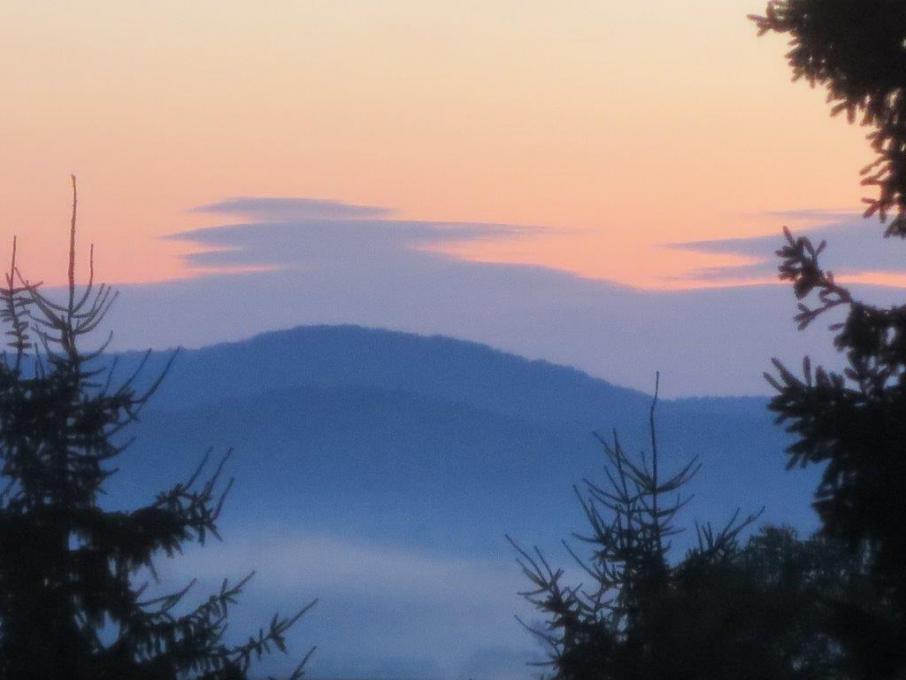


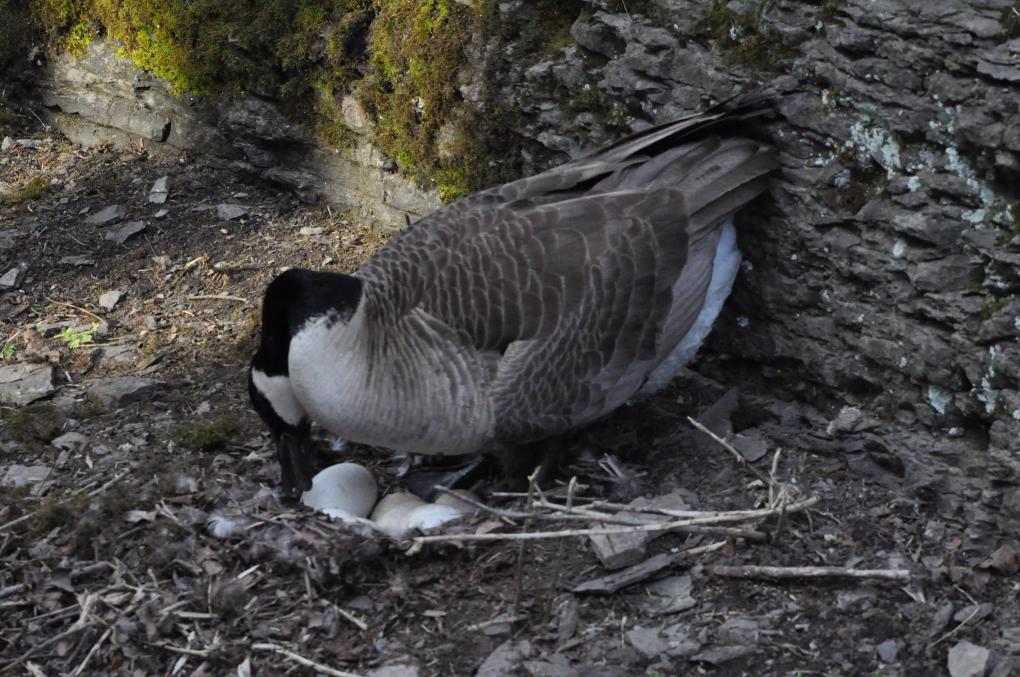

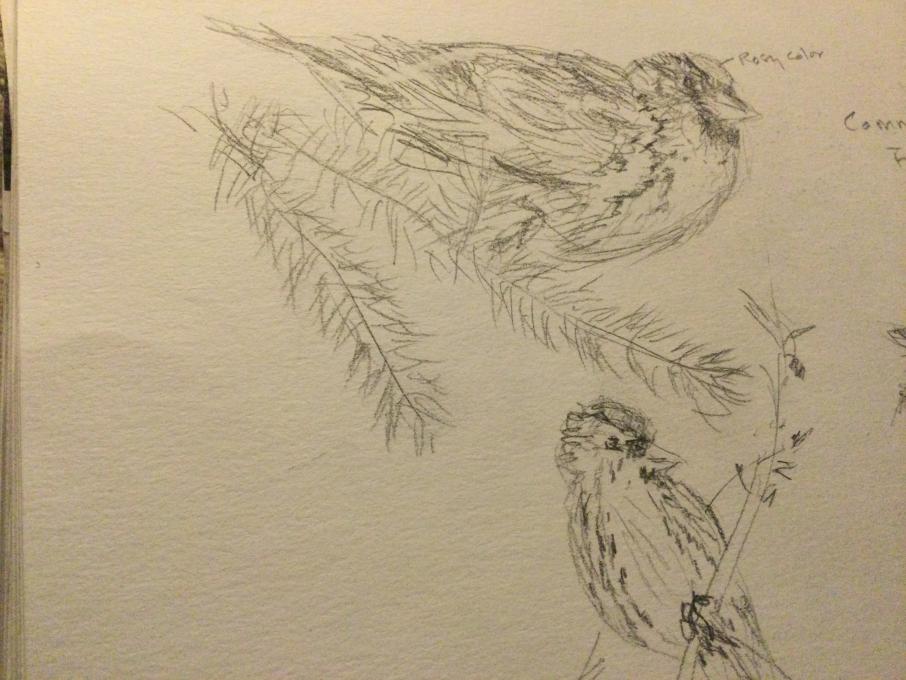


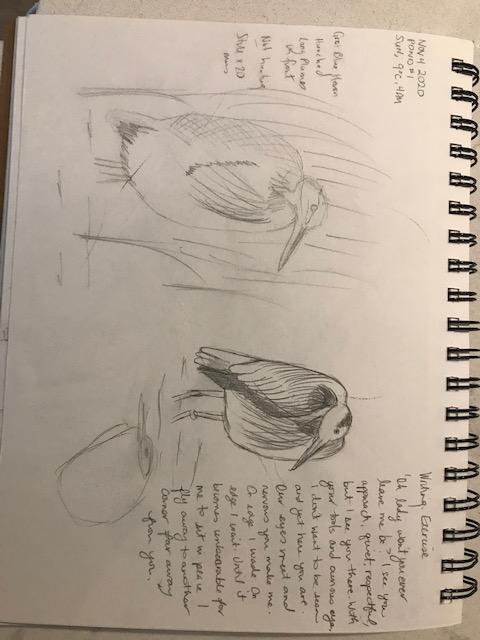
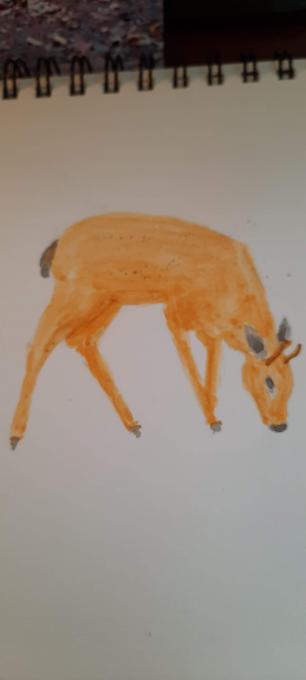 11/26/2020 Outside my Window.
What a delight, on Thanksgiving morning, to see a buck outside my dining room window just staring at me. He out-stared me, for what seemed a long time, and I finally backed away so as not to frighten him. With his measure of safety he proceeded to the backyard, piled high with fallen leaves, and first enjoyed a tasty laurel then a number of succulent bushes here and there. To my surprise, the main dish was then in the fallen leaves. He sorted through them, so it wasn’t just any leaf, but special ones. I’m not entirely sure, but it looked like it was the older leaves, wet and closer to the ground, he was after. He traveled back again to the side of the house; delicately picking just the right fallen leaves. For these magical moments, I am grateful.
What a delight, on Thanksgiving morning, to see a buck outside my dining room window just staring at me. He out-stared me, for what seemed a long time, and I finally backed away so as not to frighten him. With his measure of safety he proceeded to the backyard, piled high with fallen leaves, and first enjoyed a tasty laurel then a number of succulent bushes here and there. To my surprise, the main dish was then in the fallen leaves. He sorted through them, so it wasn’t just any leaf, but special ones. I’m not entirely sure, but it looked like it was the older leaves, wet and closer to the ground, he was after. He traveled back again to the side of the house; delicately picking just the
right fallen leaves. For these magical moments, I am grateful.
11/26/2020 Outside my Window.
What a delight, on Thanksgiving morning, to see a buck outside my dining room window just staring at me. He out-stared me, for what seemed a long time, and I finally backed away so as not to frighten him. With his measure of safety he proceeded to the backyard, piled high with fallen leaves, and first enjoyed a tasty laurel then a number of succulent bushes here and there. To my surprise, the main dish was then in the fallen leaves. He sorted through them, so it wasn’t just any leaf, but special ones. I’m not entirely sure, but it looked like it was the older leaves, wet and closer to the ground, he was after. He traveled back again to the side of the house; delicately picking just the right fallen leaves. For these magical moments, I am grateful.
What a delight, on Thanksgiving morning, to see a buck outside my dining room window just staring at me. He out-stared me, for what seemed a long time, and I finally backed away so as not to frighten him. With his measure of safety he proceeded to the backyard, piled high with fallen leaves, and first enjoyed a tasty laurel then a number of succulent bushes here and there. To my surprise, the main dish was then in the fallen leaves. He sorted through them, so it wasn’t just any leaf, but special ones. I’m not entirely sure, but it looked like it was the older leaves, wet and closer to the ground, he was after. He traveled back again to the side of the house; delicately picking just the
right fallen leaves. For these magical moments, I am grateful.
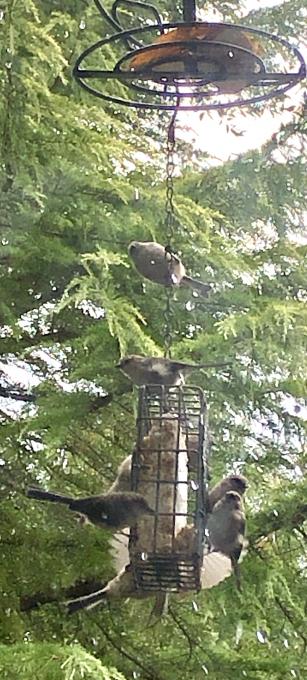

 as has inspired me for something similar but with Turk's Cap instead.
as has inspired me for something similar but with Turk's Cap instead. 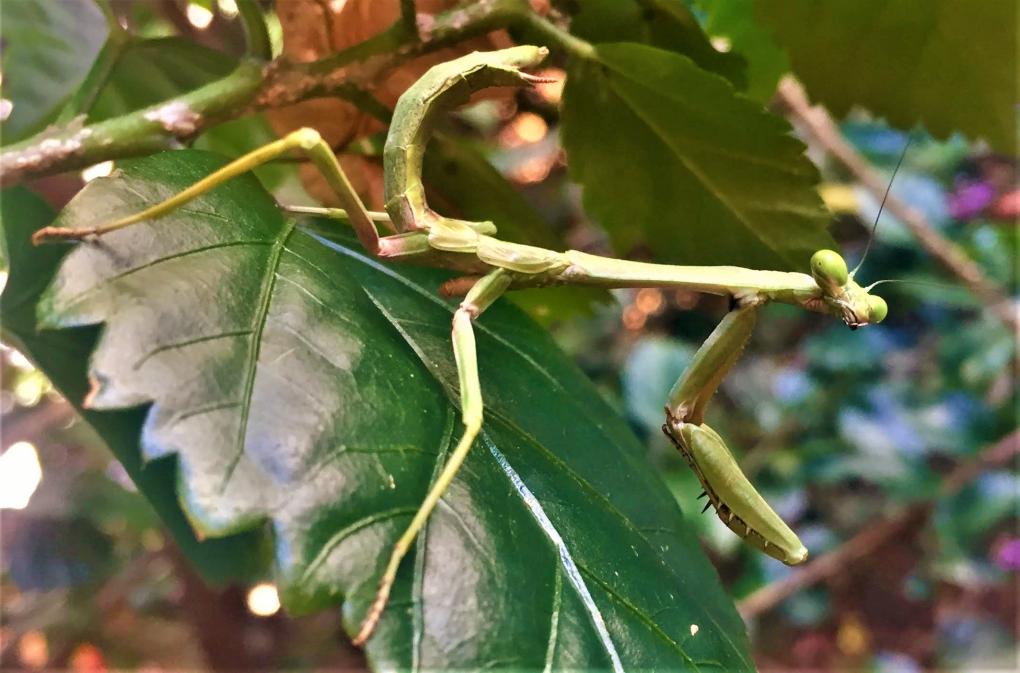 From The Perspective Of A Mantis Observing Me:
When I walked back home and got to the door of my house, I felt an uncomfortable feeling that someone was watching me. As I opened the door, the feeling became very intense. I looked scared to my right and saw two round eyes. The little mantis analized me for a long time. Sometimes I am the Observer, other times I am observed. I was surprised by the strength of her presence. I wonder what these creatures think of us.
From The Perspective Of A Mantis Observing Me:
When I walked back home and got to the door of my house, I felt an uncomfortable feeling that someone was watching me. As I opened the door, the feeling became very intense. I looked scared to my right and saw two round eyes. The little mantis analized me for a long time. Sometimes I am the Observer, other times I am observed. I was surprised by the strength of her presence. I wonder what these creatures think of us. 
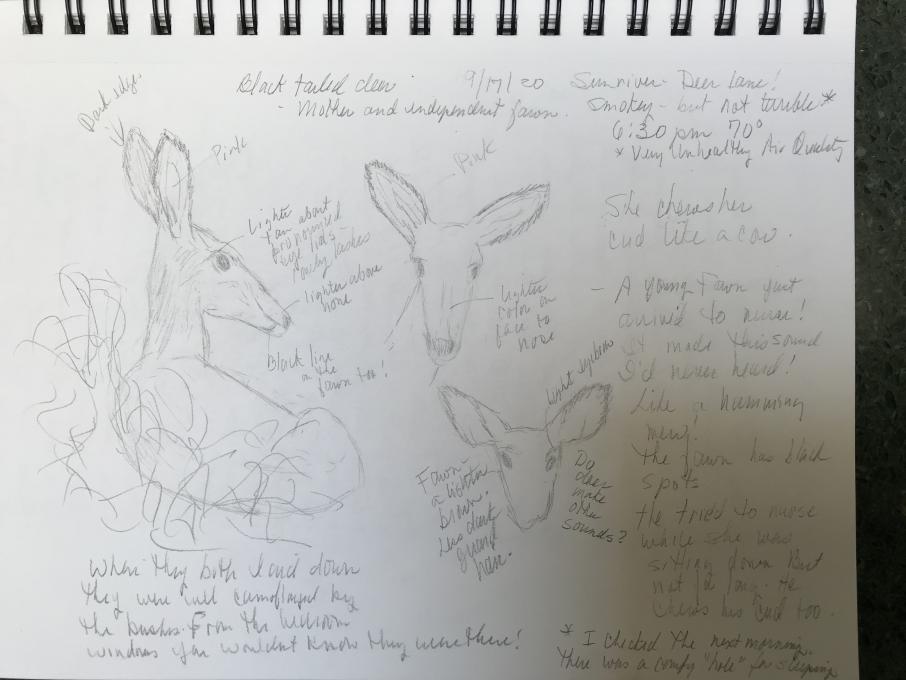 The context for my nature journaling and reflection is set against the backdrop of fire and smoke. I live in Portland, Oregon. We had rented a vacation home in eastern Oregon, months ago. Our plans were to hike and get out into the wilderness of the Cascades. The dangerous levels of smoke in the air that week forced us to stay inside.
After our last dinner, my husband began the preliminary packing of the car for the trip home the next morning. He stuck his head in the door and whispered, “You’ve got to come out here. Be really quiet. There’s a black-tailed deer bedding down, just behind the house.” I quickly grabbed my sketchbook, marveling that I might actually have a nature experience to draw! Quietly I sat down about a dozen feet from the doe. I was amazed that she didn’t flee. Her large ears and eyes stayed focused on me for a bit until she decided I was not a threat.
I have been around deer all my life, but this was the first time that I had the opportunity to observe one so closely for such an extended period of time. As I drew I appreciated the dimensions of her body, the colors and textures of her coat, the unique markings on her face and how those amazingly large ears swiveled to track the sounds around her, searching for danger.
All of the sudden behind me I heard a sound, an animal sound I’d never heard before. The sound indicated a fairly large animal. It was sort of like a “m” sound, a hum. I froze, looking out of the corner of my eye to see if I was in any danger. However, when I glanced back at the doe, her ears were still. She sat placidly chewing her cud. She sensed no danger so I relaxed. Then, a surprise burst into a view. An independent fawn, still with black spots, bounded around the corner as if to say, “Hey Mom! I’m home!” It was the fawn making that noise! I didn’t know that deer made noises. I watched them, sketching them until dusk made them disappear in perfect camouflage for the night.
My “failed” vacation ended up being one of my favorites. I learned many lessons about being still. The lesson I hold most closely came from those two deer. Even amidst the worst of times, there is beauty and wonder if you keep your eyes open and embrace opportunity.
The context for my nature journaling and reflection is set against the backdrop of fire and smoke. I live in Portland, Oregon. We had rented a vacation home in eastern Oregon, months ago. Our plans were to hike and get out into the wilderness of the Cascades. The dangerous levels of smoke in the air that week forced us to stay inside.
After our last dinner, my husband began the preliminary packing of the car for the trip home the next morning. He stuck his head in the door and whispered, “You’ve got to come out here. Be really quiet. There’s a black-tailed deer bedding down, just behind the house.” I quickly grabbed my sketchbook, marveling that I might actually have a nature experience to draw! Quietly I sat down about a dozen feet from the doe. I was amazed that she didn’t flee. Her large ears and eyes stayed focused on me for a bit until she decided I was not a threat.
I have been around deer all my life, but this was the first time that I had the opportunity to observe one so closely for such an extended period of time. As I drew I appreciated the dimensions of her body, the colors and textures of her coat, the unique markings on her face and how those amazingly large ears swiveled to track the sounds around her, searching for danger.
All of the sudden behind me I heard a sound, an animal sound I’d never heard before. The sound indicated a fairly large animal. It was sort of like a “m” sound, a hum. I froze, looking out of the corner of my eye to see if I was in any danger. However, when I glanced back at the doe, her ears were still. She sat placidly chewing her cud. She sensed no danger so I relaxed. Then, a surprise burst into a view. An independent fawn, still with black spots, bounded around the corner as if to say, “Hey Mom! I’m home!” It was the fawn making that noise! I didn’t know that deer made noises. I watched them, sketching them until dusk made them disappear in perfect camouflage for the night.
My “failed” vacation ended up being one of my favorites. I learned many lessons about being still. The lesson I hold most closely came from those two deer. Even amidst the worst of times, there is beauty and wonder if you keep your eyes open and embrace opportunity. 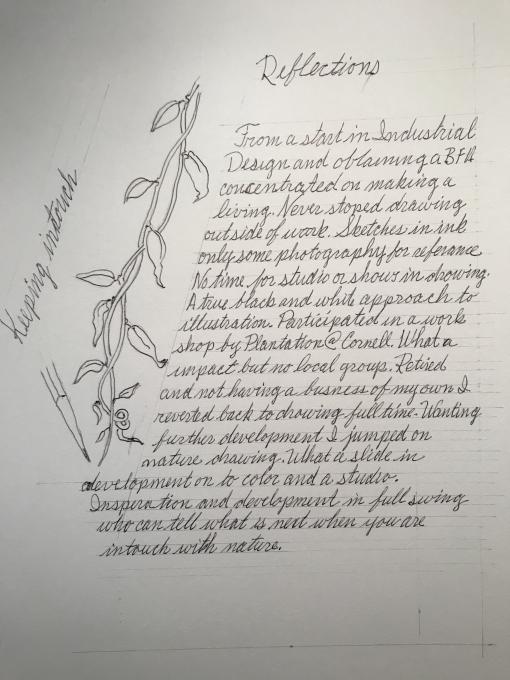
 I enjoy Ralph Waldo Emerson and Henry David Thoreau two famous Transcendentalists. I love to sit in nature soak in the sun, sound of the ocean and a forest bath and just become content in just being.
I enjoy Ralph Waldo Emerson and Henry David Thoreau two famous Transcendentalists. I love to sit in nature soak in the sun, sound of the ocean and a forest bath and just become content in just being.  This is the most recent entry from my journal. I have watched this Japanese maple for years, sometimes from the chairs I tried to include in my watercolor, sometimes looking up through the leaves while lying in a hammock. I have used its branches to teach my students about stream order in watersheds. There is a remarkable resemblance in the branching of trees and the branching in rivers. A colleague of mine dubbed it "a lightshed."
There are two poems that have stuck with me over the years. Mary Oliver's The Summer Day and Robert Frost's Nothing Gold Can Stay. I've also enjoyed reading Wendell Berry. From the Long Legged House:
"We have lived by the assumption that what was good for us would be good for the world... We have been wrong. We must change our lives, so that i it will be possible to live by the contrary assumption that what is good for the world will be good for us. And that requires that we make the effort to know the world and to learn what is good for it... For I do not doubt that it is only on the condition of humility and reverence before the world that our species will be able to remain in it."
This is the most recent entry from my journal. I have watched this Japanese maple for years, sometimes from the chairs I tried to include in my watercolor, sometimes looking up through the leaves while lying in a hammock. I have used its branches to teach my students about stream order in watersheds. There is a remarkable resemblance in the branching of trees and the branching in rivers. A colleague of mine dubbed it "a lightshed."
There are two poems that have stuck with me over the years. Mary Oliver's The Summer Day and Robert Frost's Nothing Gold Can Stay. I've also enjoyed reading Wendell Berry. From the Long Legged House:
"We have lived by the assumption that what was good for us would be good for the world... We have been wrong. We must change our lives, so that i it will be possible to live by the contrary assumption that what is good for the world will be good for us. And that requires that we make the effort to know the world and to learn what is good for it... For I do not doubt that it is only on the condition of humility and reverence before the world that our species will be able to remain in it."